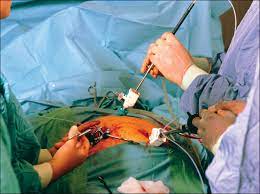Hair might be expelled from the trunk or other entry point locales. Patient will get medicine through an IV. This will help patient to unwind. Lines will be associated with patient’s finger, wrist, arm, and neck.
These are connected to machines at screen level of oxygen, heart rate, circulatory strain, and weights in patient’s veins.

Just before surgery begins, anesthesia will be given to anticipate torment and keep persistent snoozing. Rest guaranteed, surgery will not begin until the anesthesia has produced results.
Minimal Invasive Surgical Team
Patient can feel secure that his/her surgery is being finished by a group of gifted experts. Patient will be acquainted with individuals from this group before surgery begins. The group may incorporate the accompanying individuals:
A 3-to 4-inch long entry point is made through the sternum, and the bosom bone is isolated around there so the cardiovascular specialist can see the piece of the heart that needs surgery.
Utilized for mitral valve, tricuspid valve, epicardial lead position, atrial septal imperfection (ASD), patent foramen ovale (PFO), myxoma, and aortic valve surgeries.
Read More :- https://blog.docopd.com/minimal-invasive/heart-bypass-surgery
Utilized for climbing aorta, aortic valve, mitral valve, tricuspid valve, two valves, transaortic TAVR, ASD, PFO, myxoma and fibroblastoma surgeries.
The cardiovascular specialist abstains from slicing through the breastbone and, rather, cuts into muscles between the ribs to achieve the heart.
Utilized for mitral valve, tricuspid valve, ASD, PFO, myxoma surgeries
Utilized for aortic valve, transaortic TAVR and transaortic TEVAR surgeries
Utilized for negligibly intrusive direct coronary course sidestep (MIDCAB), transapical TAVR, transapical TEVAR and epicardial lead position surgeries.

Most types of robotically helped heart surgery are utilized to treat patients with mitral spewing forth. Mechanically helped heart surgery can be utilized for:

Mechanically helped heart surgery is performed through a little working entry point and three other little cuts (ports) that are made in the spaces between the ribs. The surgical instruments are connected to the mechanical arms. The instruments and a minor camera are set through the ports. Movement sensors are appended to the automated “wrist,” so the specialist can control the instruments.
Mechanically helped mitral valve surgery is performed utilizing just the little port entry points.
Coronary vein sidestep surgery might be done utilizing a negligibly intrusive cut in the space between the ribs and the ports. Contingent upon the strategy the specialist utilizes, the technique might be performed on a “thumping heart.” This implies the heart-lung sidestep machine is not utilized. This is called “off-pump” surgery.
Patient will wake up in ICU and might be he/she feels befuddled at first time after surgery.
Electrocardiogram (ECG) screen will record the beat of patient heart ceaselessly.
Patient will have a tube in mouth and throat to help them in relax. It’s awkward and patient can’t chat with it, however medical attendants will help patient to impart.
The breathing tube will remain in until patient can inhale on his/her own particular power, a couple of hours.

Patient will have respiratory treatment to keep any lung issue, for example, given way lung, contamination, or pneumonia. A medical caretaker and advisor will evaluate the patient with breathing activity like clockwork. On the off chance that fundamental request torment drug.
Patient will have active recuperation which incorporates strolling around the healing facility and other fortifying exercises. Patient will figure out how to move upper arms without harming the breastbone.
Patient will figure out how to live healthy way of life.
Minimal Invasive Surgery has undoubtedly transformed the way medical procedures are performed, offering patients a safer, less painful, and more efficient alternative to traditional open surgeries. As technology continues to advance, MIS techniques will only become more refined, further improving patient outcomes and setting new standards for surgical excellence.
Best Health Test Package Information visit here:- https://www.docopd.com/en-in/lab